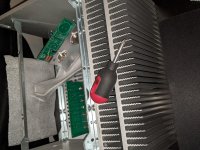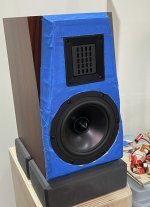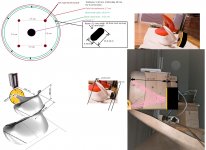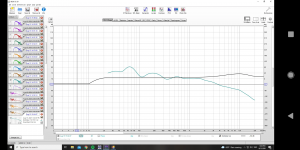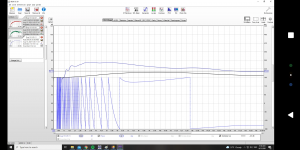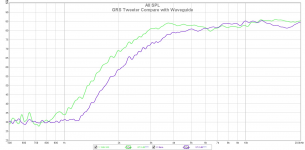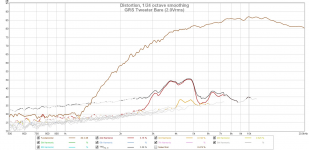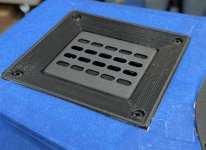They will soon have a new series on cable tv called “Pimp my Amp”! 🙂
Tonight on the bench, I installed the new waveguide and took some measurements. It’s works great. Reduces distortion and flattens the response even more. The setback will require me to redo the XO but that’s ok.
Tonight on the bench, I installed the new waveguide and took some measurements. It’s works great. Reduces distortion and flattens the response even more. The setback will require me to redo the XO but that’s ok.
Attachments
Let's see if the horn factory understands this drawing: xD
Attachments
Last edited:
You want to make an adapter for a ribbon tweeter to a “fish lips” waveguide? The transition of the ribbon housing to the waveguide is very tricky to do and not get a nasty cancellation dip. I have tried to do this with a RAAL and a tractrix and was unsuccessful.
Nano-Trynergy - a Compact Tractrix RAAL Ribbon Point-Source Horn
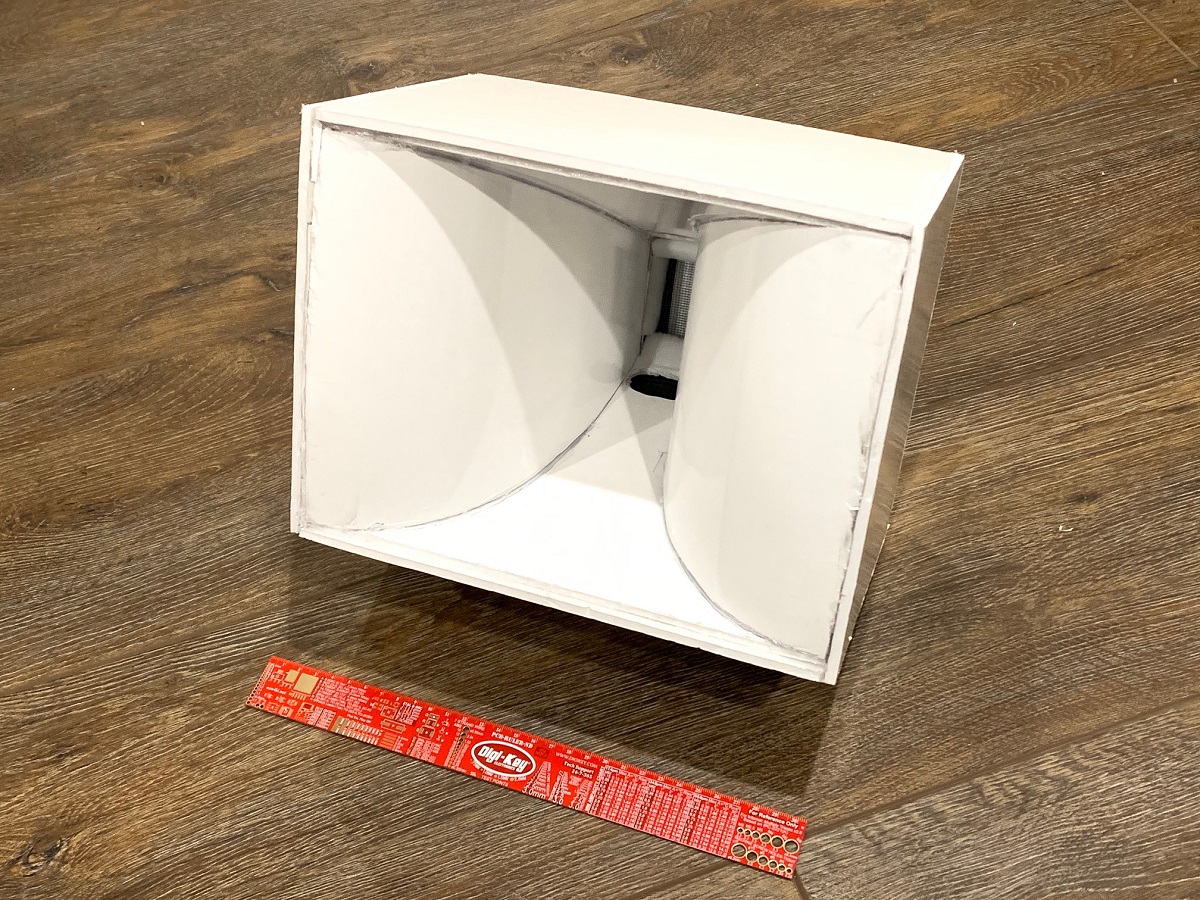
Also, for some reason, ribbons and AMTs, and planar membranes do not seem to be able to get the usual 10dB gain by putting them in a waveguide. Something about them being non-pistonic.
Nano-Trynergy - a Compact Tractrix RAAL Ribbon Point-Source Horn
Also, for some reason, ribbons and AMTs, and planar membranes do not seem to be able to get the usual 10dB gain by putting them in a waveguide. Something about them being non-pistonic.
Last edited:
I think the waveguide for the RAAL can be done if much shallower. It doesn’t like any waveguide that has semi parallel walls or a “tube” leading out of the exit plane.
You want to make an adapter for a ribbon tweeter to a “fish lips” waveguide? The transition of the ribbon housing to the waveguide is very tricky to do and not get a nasty cancellation dip. I have tried to do this with a RAAL and a tractrix and was unsuccessful.
Nano-Trynergy - a Compact Tractrix RAAL Ribbon Point-Source Horn
Also, for some reason, ribbons and AMTs, and planar membranes do not seem to be able to get the usual 10dB gain by putting them in a waveguide. Something about them being non-pistonic.
I am very pleased with my current setup with a pair of compression drivers playing 300-2500 Hz in the big horns and Raal in a horn from 2500Hz and up: More V-Fet goodness. - YouTube
Yeah, there is 4-5mm space before it arrives to the horn. Raal measures amazing from 26cm but less amazing from 3 meters and almost need a treble EQ boost as you may hear in the video. After the video I boosted the treble and it was slightly better.
Future setup: Just to check what I am missing: Two pairs of compression drivers in Iwata 220 and Iwata 600 and the Raal with no horn, or very small horn but only to boost 10k-16K. I will consider removing the faceplate somehow. Is it even possible to remove the faceplatebon a 14-150D without the ribbon falling out?
Pictures are Raal playing alone measured at 26cm and the whole system from 3 meters measured with REW and Umik-1 microphone.
Attachments
Last edited:
If you remove the faceplate, that releases the tension on the ribbon! You will have to follow the factory instructions on how to set and adjust the tension.
It is good then that I will run it without a horn., for whatever surprising reason I can motivate such a change with.
Look at what a waveguide can do here. It’s quite amazing - like it’s a totally different tweeter. For the same crossover filter, the tweeter reaches lower with more sensitivity and is flatter in response, better high end reach and distortion bump at 3kHz to 5kHz is basically gone.
With waveguide is green curve. Both are 2.0Vrms and mic is at 0.5m away:

Here is distortion without waveguide:

Here is distortion with the waveguide:

It’s amazing what a shallow waveguide can do.

With waveguide is green curve. Both are 2.0Vrms and mic is at 0.5m away:
Here is distortion without waveguide:
Here is distortion with the waveguide:
It’s amazing what a shallow waveguide can do.
Attachments
Last edited:
Ok, well still prefer the Raal I think for sound quality. I can try a shallow waveguide on the raal.
I like to listen to my portable radio. I listen to am only but the quality of sound could be better. For your future project how about a mono portable radio. I like to see what you can come up with.
Hi Audiostar,
Do you mean like AM/FM radio? I pretty much only listen to music from my smartphone via either Bluetooth speakers or earbuds. When at a desk I can use large headphones and a proper headphone amp. My main gripe with radio (except NPR) is that there is a commercial every 6 minutes. It’s so annoying.
I mostly use Amazon HD music player now when out and about. My family also uses Spotify.
So if you really want better AM/FM radio sound, have you tried a higher quality radio like a Sony or Grundig? You can get a portable powered speaker and connect via the auxiliary input.
In the early 1980’s I had a small earphone out only portable FM radio the size of a cassette tape (I believe the brand was Yamazaki). It had fantastic sound quality and reception was superb. I have not looked for something like that since.
I believe portable radios should have analog knob tuning. Why? It is easier to coax good reception out of it than a digital tuner. I have had great luck with Sony’s in the past so wondering if this can work? It’s a update to their classic product that lasted 30 years. The new one runs 100hrs on a pair of AA batteries.
Sony ICFP26 Portable AM/FM Radio,Black https://www.amazon.com/dp/B012F0DGYE/ref=cm_sw_r_cp_api_glt_fabc_CMZ3SDB6GQ1ZQCS03BW0
Now, connect the earphone output to a nice powered speaker like my Rockville and a small internal Class D amp (TDA8932) and either batteries or 12v wall wart and you have a very nice sounding “radio”.
Edit: apparently this Sony knockoff has better reception than the Sony. Solid ratings on Amazon.
Transistor Radios Portable Battery Operated - Best Reception and Longest Lasting. AM FM Radio Operated by 2 AA Battery, Mono Headphone Socket, by Vondior (Silver) https://www.amazon.com/dp/B07TSFHFR...abc_G7CH21SA23F3GKFA4F8G?_encoding=UTF8&psc=1
Do you mean like AM/FM radio? I pretty much only listen to music from my smartphone via either Bluetooth speakers or earbuds. When at a desk I can use large headphones and a proper headphone amp. My main gripe with radio (except NPR) is that there is a commercial every 6 minutes. It’s so annoying.
I mostly use Amazon HD music player now when out and about. My family also uses Spotify.
So if you really want better AM/FM radio sound, have you tried a higher quality radio like a Sony or Grundig? You can get a portable powered speaker and connect via the auxiliary input.
In the early 1980’s I had a small earphone out only portable FM radio the size of a cassette tape (I believe the brand was Yamazaki). It had fantastic sound quality and reception was superb. I have not looked for something like that since.
I believe portable radios should have analog knob tuning. Why? It is easier to coax good reception out of it than a digital tuner. I have had great luck with Sony’s in the past so wondering if this can work? It’s a update to their classic product that lasted 30 years. The new one runs 100hrs on a pair of AA batteries.
Sony ICFP26 Portable AM/FM Radio,Black https://www.amazon.com/dp/B012F0DGYE/ref=cm_sw_r_cp_api_glt_fabc_CMZ3SDB6GQ1ZQCS03BW0
Now, connect the earphone output to a nice powered speaker like my Rockville and a small internal Class D amp (TDA8932) and either batteries or 12v wall wart and you have a very nice sounding “radio”.
Edit: apparently this Sony knockoff has better reception than the Sony. Solid ratings on Amazon.
Transistor Radios Portable Battery Operated - Best Reception and Longest Lasting. AM FM Radio Operated by 2 AA Battery, Mono Headphone Socket, by Vondior (Silver) https://www.amazon.com/dp/B07TSFHFR...abc_G7CH21SA23F3GKFA4F8G?_encoding=UTF8&psc=1
Last edited:
I have a Sony FM/AM icf -38 portable radio. It is OK, I use it for talk radio rather than music. Tivoli PAL is suppose to be good but is expensive at $200. It seems to me, the audiophile community is not interested in portable AM/FM radio. I wonder what a diyer could create in regards to portable radio with battery and plug into wall outlet.
A DIY effort won’t be less than $200 Tivoli. It will sound better though. Getting good FM tuner is key to all this. The amp and speakers we can handle.
I really would just put a $7 mono Class D amp inside the Rockville. Give it a 5.5mm barrel jack for power and 3.5mm jack for audio input, connect the stereo to mono with two 2k2 resistors in a “Y”.
You could connect your smartphone or whatever and the sound would be very good.
I really would just put a $7 mono Class D amp inside the Rockville. Give it a 5.5mm barrel jack for power and 3.5mm jack for audio input, connect the stereo to mono with two 2k2 resistors in a “Y”.
You could connect your smartphone or whatever and the sound would be very good.
Great memories of those audiostar. Here's my XRK inspired, foamcore Boombox! It has a TPA3116 based 2.1 channel plate amp. I still use it in my shop for background music.
Foam Core Board Speaker Enclosures?
As for a DIY radio, I think the hard part is the tuner itself. In vintage electronics repair the tuner is the one part everyone says to stay away from modifying or "repairing" unless you REALLY know what you're doing. I assume there's sound reasoning behind that.
Foam Core Board Speaker Enclosures?
As for a DIY radio, I think the hard part is the tuner itself. In vintage electronics repair the tuner is the one part everyone says to stay away from modifying or "repairing" unless you REALLY know what you're doing. I assume there's sound reasoning behind that.
Hi Jwjarch,
I forgot all about that speaker. Looks great!

The one by Skyrocket above that is awesome too:
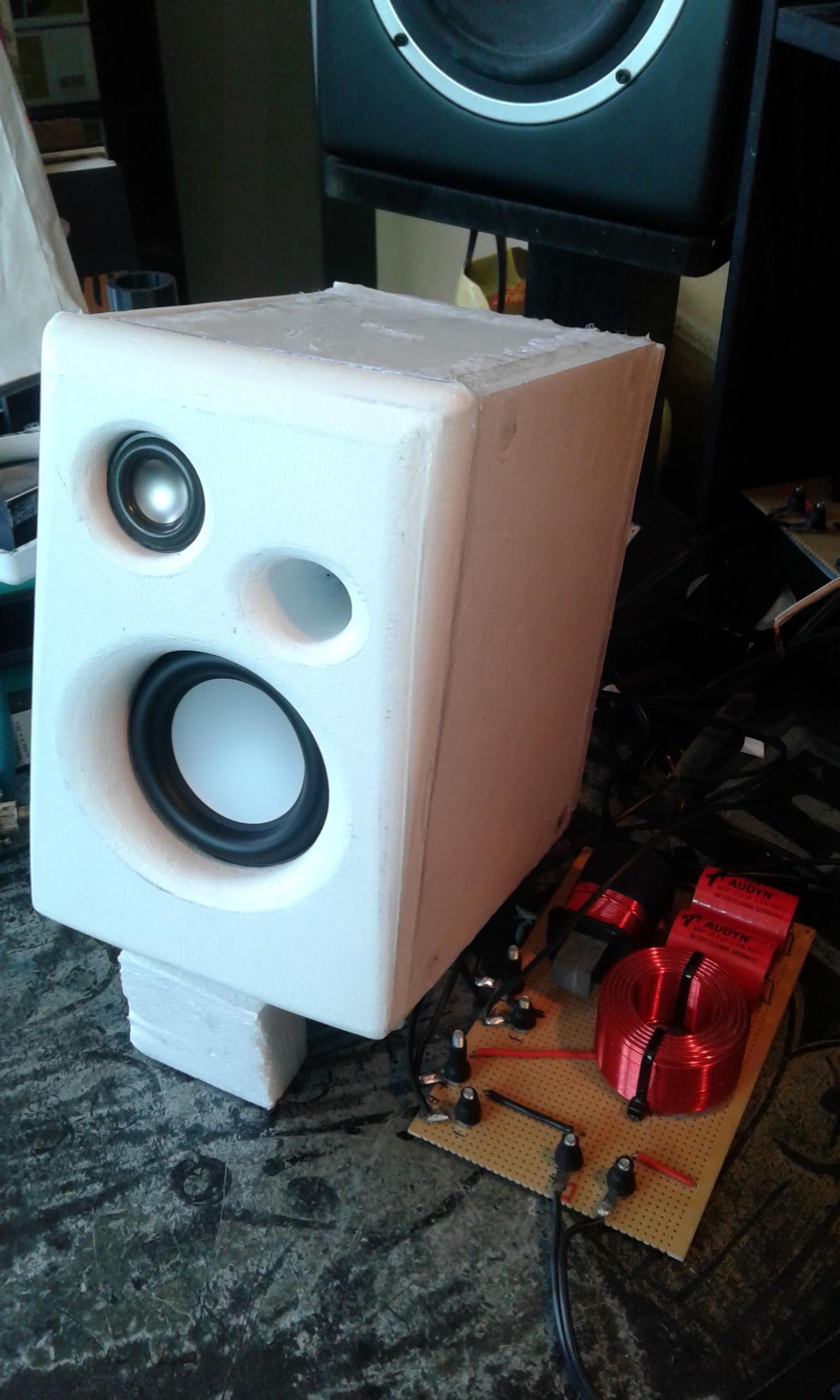
I forgot all about that speaker. Looks great!

The one by Skyrocket above that is awesome too:
Thanks X! That was one of the builds that really got me hooked on diyAudio. Can’t believe that was 4 years ago!
You have come a long way in 4 years! I would have thought you have been doing this much longer. 🙂
I did not do anything in audio until I joined DIYA almost 9 years ago when I wanted to build my own BT speaker for cheaps. What I learned was, you can’t beat a commercially designed compact BT speaker with a DIY effort. However, you CAN beat commercial power amps, headphone amps, DACs, and speakers with DIY.
I did not do anything in audio until I joined DIYA almost 9 years ago when I wanted to build my own BT speaker for cheaps. What I learned was, you can’t beat a commercially designed compact BT speaker with a DIY effort. However, you CAN beat commercial power amps, headphone amps, DACs, and speakers with DIY.
